Père Lachaise Cemetery
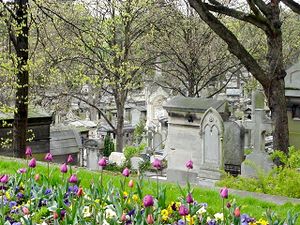
Père Lachaise Cemetery (French: Cimetière du Père-Lachaise; officially, cimetière de l'Est, "East Cemetery") is the largest cemetery in the city of Paris, France (48 ha, 118.6 acres),[1] though there are larger cemeteries in the city's suburbs.
Père Lachaise is one of the most famous cemeteries in the world. Located in the 20th arrondissement, it is reputed to be the world's most-visited cemetery, attracting hundreds of thousands of visitors annually to the graves of those who have enhanced French life over the past 200 years. It is also the site of three World War I memorials.
Père Lachaise is located on Boulevard de Ménilmontant. Métro station Philippe Auguste on line 2 is next to the main entrance, while the station called Père Lachaise, on line 3, is 500 metres away near a side entrance. Many tourists prefer the Gambetta station on line 3 as it allows them to enter near the tomb of Oscar Wilde and then walk downhill to visit the rest of the cemetery.
Origins
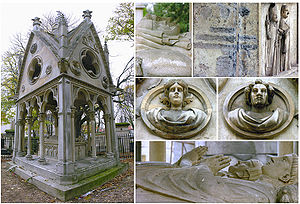
The cemetery takes its name from the confessor to Louis XIV, Père François de la Chaise (1624–1709), who lived in the Jesuit house rebuilt in 1682 on the site of the chapel. The property, situated on the hillside from which the king during the Fronde, watched skirmishing between the Condé and Turenne, was bought by the city in 1804. Established by Napoleon 1 in this year, the cemetery was laid out by Alexandre-Théodore Brongniart, and later extended.
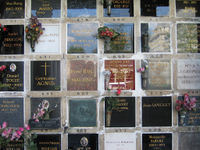
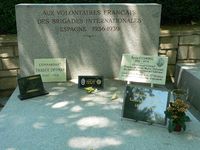
Cemeteries had been banned inside Paris in 1786, after the closure of the Saints Innocents Cemetery (Cimetière des Innocents) on the fringe of Les Halles food market, on the grounds that it presented a health hazard. (This same health hazard also led to the creation of the famous Parisian catacombs in the south of the city.) Several new cemeteries replaced the Parisian ones, outside the precincts of the capital: Montmartre Cemetery in the north, Père Lachaise in the east, and Montparnasse Cemetery in the south. At the heart of the city, in the shadow of the Eiffel Tower, is Passy Cemetery.
At the time of its opening, the cemetery was considered to be situated too far from the city and attracted few funerals. Consequently, the administrators devised a marketing strategy and with great fanfare organised the transfer of the remains of La Fontaine and Molière, in 1804. Then, in another great spectacle in 1817, the purported remains of Pierre Abélard and Héloïse were also transferred to the cemetery with their monument's canopy made from fragments of the abbey of Nogent-sur-Seine (by tradition, lovers or lovelorn singles leave letters at the crypt in tribute to the couple or in hope of finding true love) (see disputation).
This strategy achieved its desired effect when people began clamouring to be buried among the famous citizens. Records show that, within a few years, Père Lachaise went from containing a few dozen permanent residents to more than 33,000. Today there are over 300,000 bodies buried there, and many more in the columbarium, which holds the remains of those who had requested cremation.
The Communards' Wall (Mur des Fédérés) is also located in the cemetery. This is the site where 147 Communards, the last defenders of the workers' district of Belleville, were shot on 28 May 1871 — the last day of the "Bloody Week" (Semaine Sanglante) in which the Paris Commune was crushed.
After that week, the cemetery gained a special importance to the political left in France, manifested in annual processions sometimes drawing tens or even hundreds of thousands of participants (some 600,000 in 1936) and led by the main leaders of the left parties and organizations. Various prominent left-wing leaders are buried in the vicinity, where a monument was also erected honouring the French Brigadists (volunteers in the International Brigades in the Spanish Civil War).
Adolphe Thiers, widely blamed for the massacres of "Bloody Week", is an ironic resident of the cemetery. His tomb has occasionally been subject to vandalism.
Burials
Among those interred here are:
Contents: Top · 0–9 A B C D E F G H I J K L M N O P Q R S T U V W X Y Z
A
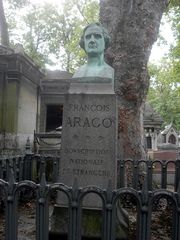
- Peter Abelard — French philosopher
- Edmond François Valentin About — French novelist and journalist
- Marie d'Agoult — French author who wrote under the nom de plume of Daniel Stern
- Jehan Alain — French composer and organist
- Marietta Alboni — Italian opera singer
- Jean-Charles Alphand — French civil engineer
- Karel Appel — Dutch painter
- Guillaume Apollinaire — French poet and art critic
- François Arago — French scientist and statesman
- Armand Pierre Fernandez — French painter
- Miguel Ángel Asturias — Guatemalan diplomat and author, won the Nobel Prize for Literature in 1967
- Daniel Auber — French composer
- Hubertine Auclert — French feminist and activist for women's suffrage
- Pierre Augereau — French military commander and Marshal of France
- Jean-Pierre Aumont — French actor, father of Tina Aumont and husband of Maria Montez
- Jane Avril — French dancer
B

- Salvador Bacarisse — Spanish composer
- Honoré de Balzac — French novelist of the 19th century
- Henri Barbusse — French novelist
- Paul Barras — French statesman
- Antoine-Louis Barye — French sculptor
- Alain Bashung — French singer
- Jean-Dominique Bauby — French journalist
- Jean-Louis Baudelocque — French obstetrician
- Gilbert Bécaud — French singer
- Pierre Augustin Béclard — French anatomist
- Vincenzo Bellini — Italian composer; remains later transferred to Italy
- Judah P. Benjamin — American lawyer and statesman
- Pierre-Jean de Béranger — French lyricist
- Claude Bernard — French physiologist, known for several advances in medicine, as the introduction of the scientific method to the study of medicine, and the study of the sympathetic nervous system.
- Bernardin de Saint Pierre — French writer
- Sarah Bernhardt — French stage and film actress
- Alphonse Bertillon — French anthropologist and father of anthropometry
- Julien Bessières - French scientist, diplomat and politician
- Ramón Emeterio Betances — Puerto Rican nationalist
- Marie François Xavier Bichat — French anatomist and physiologist
- Fulgence Bienvenue — French civil engineer remembered as the Father of the Paris Metro
- Samuel Bing — German art dealer
- Georges Bizet — French composer and conductor
- Louis Blanc — French historian and statesman
- Sophie Blanchard — first professional female balloonist and the first woman to die in an aviation accident
- Auguste Blanqui — French statesman
- Rosa Bonheur — French painter
- Ludwig Börne — German political writer and satirist
- Pierre Bourdieu — French sociologist
- Alexandrine-Caroline Branchu — French opera singer
- Édouard Branly — French scientist
- Pierre Brasseur — French comedian
- Jean Anthelme Brillat-Savarin — French Lawyer, Politician, Epicure, and Gastronome
- Alexandre-Théodore Brongniart — French architect, best known for designing the layout of the Pėre Lachaise Cemetery
- Pierre Brossolette — French journalist, politician and Résistance leader
- Jean de Brunhoff — French author of Babar the Elephant
- Auguste-Laurent Burdeau — French politician and plaintiff in the Drumont-Burdeau trial
C
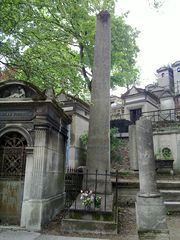
- Joseph Caillaux — French statesman
- Gustave Caillebotte — French Impressionist painter
- Maria Callas — The opera singer's ashes were originally buried in the cemetery. After being stolen and later recovered, they were scattered into the Aegean Sea, off the coast of Greece. The empty urn remains in Père Lachaise.
- Jean Jacques Régis de Cambacérès — French lawyer and politician
- Giulia Grisi de Candia — Italian opera singer, well known as "Giulia Grisi", her grave is marked Giullia de Candia.
- Jean-Joseph Carriès — French sculptor, ceramist, and miniaturist
- Pierre Cartellier — French sculptor
- Jean-François Champollion — French decipherer of the hieroglyphs and father of Egyptology
- Claude Chappe — French pioneer of the telegraph
- Ernest Chausson — French composer
- Richard Chenevix — Irish chemist
- Luigi Cherubini — Italian composer
- Claude de Choiseul-Francières — Marshal of France
- Frédéric Chopin — Polish composer. His heart is entombed within a pillar at the Holy Cross Church in Warsaw.
- Alain Clément — French journalist and writer
- Jean-Baptiste Clément — French painter and activist
- Auguste Clésinger - French painter and sculptor
- Émile Cohl — French cartoonist
- Colette — French litterateur
- Count Alexandre Joseph Colonna-Walewski — French statesman, son of Napoleon I
- Auguste Comte — French thinker; father of Positivism
- Benjamin Constant — Swiss-born liberal philosopher
- Bruno Coquatrix — French lyricist and music impresario
- Jean-Baptiste-Camille Corot — French painter
- Jean-Pierre Cortot — French sculptor
- Benoît Costaz — French bishop
- Georges Courteline — French playwright
- Thomas Couture — French painter
- Nancy Cunard — English poet and activist
- Henri Curiel — Egyptian politician
- Georges Cuvier — the founder of paleontology
D

- Jarosław Dąbrowski — exiled Polish revolutionary Nationalist and last Commander-in-Chief of the Paris Commune of 1871
- Pierre Dac — French humorist
- Édouard Daladier — French Radical-Socialist politician of the 1930s, signatory of the Munich Agreement in 1938 and Prime Minister of France at the outbreak of the Second World War
- Alexandre Darracq — French automobile manufacturer
- Alphonse Daudet — Famous French author who is known for his literary works, such as, "Lettres de mon Moulin".
- R. L. Daus — French-American architect
- Honoré Daumier — French caricaturist
- Jacques-Louis David — Napoleon's court painter was exiled as a revolutionary after the Bourbons returned to the throne of France. His body was not allowed into the country even in death, so the tomb contains only his heart.
- David d'Angers — French sculptor
- Louis Nicolas Davout — Napoleon's "Iron Marshal"
- Gérard Debreu — French economist, won the Nobel Prize for Economics in 1983
- Jean-Gaspard Deburau — Czech-born French actor and mime
- Denis Decrès — French admiral and Naval Minister under Napoleon
- Cino Del Duca — Italian-born French publishing magnate, film producer and philanthropist
- Simone Del Duca — French businesswoman and philanthropist, wife of Cino Del Duca
- Eugène Delacroix — French Romantic artist
- Jean Baptiste Joseph Delambre — French mathematician
- Vivant Denon — French archaeologist
- Pierre Desproges — French humorist
- Gustave Doré — French artist and engraver
- Michel Drach — French film director
- Marie Dubas — French singer
- Jacques Duclos — French politician
- Paul Dukas — French composer
- Isadora Duncan — American dancer
- Henri Duparc — French composer
- Eleonore Duplay — Friend of French revolutionary Maximilien Robespierre
- Guillaume Dupuytren — French surgeon
E
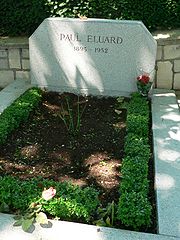
- Paul Éluard — French surrealist poet
- George Enescu — Romanian composer, pianist, violinist and conductor
- Camille Erlanger — French composer
- Max Ernst — German artist
F
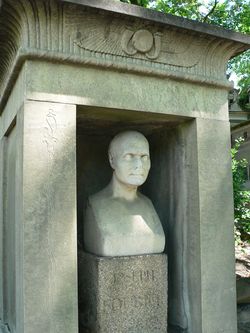
- Alexandre Falguière — French sculptor
- Félix Faure — former President of France
- Robert de Flers — French playwright and journalist
- Suzanne Flon — actress
- Jean de La Fontaine — French litterateur best known for fairy tales
- Joseph Fourier — French mathematician and physicist
- Jean Françaix — French composer
- Pierre Frank — French Trotskyist politician
- William Temple Franklin — grandson of Benjamin Franklin
- Loie Fuller — French dancer
G
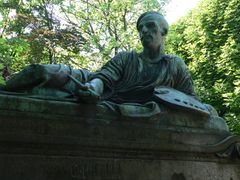
- Antonio de la Gandara — French painter
- Louis-Antoine Garnier-Pagès — French statesman
- Joseph Louis Gay-Lussac — French chemist and physicist
- Pierre Georges — French Resistance leader better known as Colonel Fabien
- Théodore Géricault — French Romantic painter, whose major work The Raft of the Medusa is reproduced on his tomb by sculptor Antoine Étex.
- Sophie Germain — Early French female mathematician, physicist, and philosopher
- Abdul Rahman Ghassemlou — leader of the Democratic Party of Iranian Kurdistan
- André Gill — French caricaturist
- Manuel de Godoy — Spanish prime minister and court favorite
- Yvan Goll — French-German poet and his wife Claire Goll
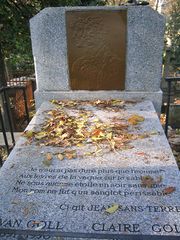
- Enrique Gómez Carrillo — Guatemalan novelist, journalist, war correspondent, chronicler and diplomat, lived most of his life in Europe; he was the correspondent to important newspapers in Spain and Argentina; published 86 books between novels and chronicles of his journeys to faraway places.
- Laurent de Gouvion Saint-Cyr — French military commander and Marshal of France
- Zénobe Gramme — Inventor of the Direct Current (DC) Dynamo. There is a statue on the grave of Zénobe sitting and looking at a dynamo rotor.
- Stéphane Grappelli — French jazz violinist and member of the Quintette du Hot Club de France
- André Grétry — Belgian-born French composer
- Maurice Grimaud — French Prefecture of Police during May 1968[2]
- Giulia Grisi — Italian opera singer. Her grave is marked under her married name Giulia de Candia.
- Félix Guattari — French militant, institutional psychotherapist and philosopher
- Jules Guesde — French statesman
- Yvette Guilbert — actress and singer
- Joseph-Ignace Guillotin — proposed the guillotine as the official method of execution in France
- Yılmaz Güney — Kurdish Turkish actor and film director
H
- Samuel Hahnemann — German physician, founder of homeopathy
- Georges Haussmann — French civil engineer and town planner
- Jeanne Hébuterne — French artist and common-law wife of the artist Amedeo Modigliani
- Sadegh Hedayat — Iran's foremost modern writer of prose fiction and short stories
- Heloïse — French abbess and scholar, best known for her love affair with Peter Abelard
- Ticky Holgado — French actor
- Jean-Nicolas Huyot — French architect best known for his work on the Arc de Triomphe
I
- Jean Auguste Dominique Ingres — French painter
- Jean-Baptiste Isabey — French painter
J
- Claude Jade — French actress
- Léon Jouhaux — French trade union leader, won the Nobel Peace Prize in 1951
K
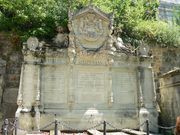
- Allan Kardec — born Hippolyte Leon Denizard Rivail, founder of Spiritism
- Ahmet Kaya — Kurdish singer and songwriter and political exile
- François Christophe de Kellermann — French military commander and Marshal of France
- Thomas Read Kemp — English property developer and statesman
- Henri Krasucki — French trade unionist
- Rodolphe Kreutzer — French violinist and composer
L
- Jérôme Lalande — French astronomer and writer
- René Lalique — French glass designer
- Édouard Lalo — French composer
- Theophanis Lamboukas — French actor and singer, husband of Édith Piaf
- Francisco Largo Caballero — Former president of the Spanish II Republic.
- Dominique Jean Larrey — French military surgeon
- Clarence John Laughlin — American Surrealist photographer from New Orleans, Louisiana. His most famous published work was "Ghosts Along the Mississippi".
- Marie Laurencin — French painter
- Charles-François Lebrun — French statesman
- Alexandre Ledru-Rollin — French politician
- Louis James Alfred Lefébure-Wély — French organist and composer
- François Joseph Lefebvre — French military commander and Marshal of France
- Ferdinand de Lesseps — French architect, designed the Suez Canal
- Pierre Levegh — French racing driver killed in the 1955 Le Mans disaster
- Jean-François Lyotard — French philosopher
M
- Jacques MacDonald — French military commander and Marshal of France
- William Madocks — English landowner and statesman
- Milosz Magin — Polish composer
- Nestor Makhno — Ukrainian revolutionary
- Jacques-Antoine Manuel — French lawyer and statesman
- Auguste Maquet — French author
- Marcel Marceau— French mime artist
- Angelo Mariani — French chemist
- Célestine Marié — French opera singer
- André Masséna — French military commander and Marshal of France
- Georges Méliès— French filmmaker; produced A Trip to the Moon
- Émile-Justin Menier — French chocolatier
- Henri Menier — French chocolatier
- Antoine Brutus Menier — French chocolatier
- Maurice Merleau-Ponty— French philosopher
- Cléo de Mérode — French dancer
- Stuart Merrill — American symbolist poet
- Charles Messier — French astronomer, publisher of Messier's catalogue
- Jules Michelet — French historian
- Amedeo Modigliani — Italian painter and sculptor. Famous for his intense rivalry with Pablo Picasso.
- Molière — French playwright
- Gustave de Molinari — Belgian-born economist associated with French laissez-faire liberal economists.
- Silvia Monfort — French comedienne
- Gaspard Monge — French mathematician; remains later moved to the Panthéon
- Yves Montand — film actor
- Jim Morrison — American singer and songwriter with The Doors, author, and poet. Permanent crowds and occasional vandalism surrounding this tomb have caused tensions with the families of other, less famous, interred individuals.[3] Many other parts of the cemetery have been defaced with arrows purporting to indicate the direction toward "Jim", though even these defacements have in many cases been defaced themselves, resulting in arrows that point in two directions.
- Jean Moulin — leader of the French Resistance during World War II who went missing after his arrest with several other Resistants at Caluire, Lyon in June 1943. Understood to have died on a train not far from Metz station in July that year, ashes 'presumed' to be his were interred at Pere Lachaise after the war and then transferred to the Panthéon in December 1964.
- Marcel Mouloudji — French singer
- Joachim Murat — French Napoleonic general and Marshal of France.
- Alfred de Musset — French poet, novelist, dramatist; love affair with George Sand is told from his point of view in his autobiographical novel, La Confession d'un Enfant du Siècle
N
- Félix Nadar — a French photographer, caricaturist, journalist, novelist and balloonist
- Francine Navarro - crown princess of Montenegro, wife of prince Nikola II. Petrović-Njegoš
- Gérard de Nerval — French poet
- Michel Ney — Marshal of France who fought in the French Revolutionary War and the Napoleonic Wars
- Anna de Noailles — French poetess
- Charles Nodier — French writer
- Victor Noir — journalist killed by Pierre Napoleon Bonaparte in a dispute over a duel with Paschal Grousset. The tomb, designed by Jules Dalou, is notable for the realistic portrayal of the dead Noir.
- Cyprian Norwid — Polish poet
O
- Pascale Ogier — French actress
- Virginia Oldoini, Countess di Castiglione — famous Italian courtesan
- Max Ophüls — German film director
- Andranik Toros Ozanian — Armenian military commander and statesman
P
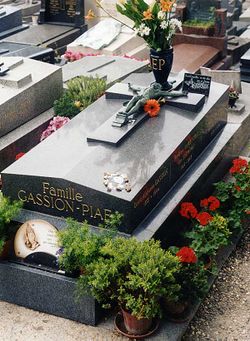
- Antoine Parmentier — French agronomist known for enunciating the dietary value of potatoes
- Alexandre Ferdinand Parseval-Deschenes — French admiral
- François-Auguste Parseval-Grandmaison — French poet, uncle of the above
- Christine Pascal — French actress
- Adelina Patti — Spanish-born opera singer
- Robert Herbert, 12th Earl of Pembroke — English aristocrat
- Casimir Perier — French statesman
- Michel Petrucciani — French Jazz pianist
- Édith Piaf — French singer
- Christian Pineau — French statesman
- Roland Piquepaille — French technology writer
- Camille Pissarro — French Impressionist painter
- Ignace Pleyel — pianist
- Elvira Popescu — Romanian actress
- Francis Poulenc — French composer
- Antoine-Augustin Préault — French sculptor
- Marcel Proust — French novelist, essayist and critic
- Pierre-Paul Prud'hon — French painter
R
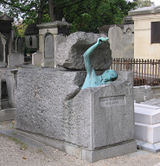
- Mademoiselle Rachel — French actress
- François-Vincent Raspail — French scientist and statesman; remains later moved to the Panthéon
- Pierre-Joseph Redouté — Belgian botanic illustrator
- Henri de Régnier — French poet
- Norbert Rillieux — American engineer, invented the multiple-effect evaporator
- Étienne-Gaspard Robert — Belgian magician who performed under the stage name of Robertson
- Jacob Roblès — Famous grave for the medallion Silence by Auguste Préault
- Georges Rodenbach — Belgian poet
- Jules Romains — French writer
- Gioachino Rossini — Italian composer. In 1887, Rossini's remains were moved back to Florence, but the crypt that once housed them (now dedicated to his memory) still stands in Perè Lachaise.
- Edmond James de Rothschild — Baron of the Rothschild family
- Salomon James de Rothschild — son of James de Rothschild
- Raymond Roussel — writer
- Alphonse Royer — French poet and dramatist
S
- Gholam Hossein Saedi — Iranian socialist novelist and playwright
- Sadeq Hedayat - Iranian novelist and writer
- Countess Consuelo de Saint-Exupéry — Salvadoran writer, wife of Antoine de Saint-Exupéry
- Geoffroy Saint-Hilaire — French naturalist
- Claude Henri de Rouvroy, Comte de Saint-Simon — French sociologist who founded the "Saint-Simonian" movement
- Henri Salvador — French singer
- Yuliya Samoylova — Russian aristocrat
- Jean-Baptiste Say — French economist
- Victor Schoelcher — French statesman known for the abolition of slavery
- Raymond Adolphe Séré de Rivières — French general and military engineer
- Georges-Pierre Seurat — French painter of Sunday Afternoon on the Island of La Grande Jatte, and father of neoimpressionism
- Emmanuel-Joseph Sieyès — French clergyman, philosopher and statesman
- Simone Signoret — Academy-award winning French actress.
- William Sidney Smith — British admiral, of whom Napoleon Bonaparte said "That man made me miss my destiny".
- Paul Signac — French painter
- Serge Alexandre Stavisky — French financier
- Gertrude Stein — American author
- Elisabeta Alexandrovna Stroganova — Francophile Russian aristocrat
- Louis Gabriel Suchet — French military commander and Marshal of France
T
- Eugenia Tadolini — Italian opera singer
- François-Joseph Talma — French actor
- Pierre Alexandre Tardieu — French engraver
- Gerda Taro — German war photographer and the great love of Robert Capa, also one of the iconographers of the Spanish Civil War. The monument is by Alberto Giacometti.
- Jehangir Ratanji Dadabhoy Tata — Indian aviation pioneer and industrialist
- Tapa Tchermoeff — First Prime Minister of the Mountainous Republic of the Northern Caucasus
- Thomas Tellefsen — Norwegian pianist and composer
- Ruben Ter-Minasian — Armenian politician and a revolutionary, member of Armenian Revolutionary Federation ARF Tashnag
- Adolphe Thiers — French historian and statesman
- Maurice Thorez — French Communist politician
- Isaac Titsingh — Dutch surgeon, scholar, VOC trader, ambassador to Qing China and Tokugawa Japan
- Alice B. Toklas — American author, partner of Gertrude Stein, Toklas' name and information is etched on the other side of Stein's gravestone in the same sparse style and font.
- Marie Trintignant — French actress
- Maurice Tourneur — French film director
- Rafael Leónidas Trujillo — former dictator of the Dominican Republic
- Ramfis Trujillo — Lt. Gen. in the Dominican Republic, son of dictator Gen. Trujillo
V
- Paul Vaillant-Couturier — French political journalist
- Pierre-Henri de Valenciennes — French painter
- Jules Valles — French writer
- Louis Verneuil — French playwright
- Claude Victor-Perrin — French military commander and Marshal of France
- Louis Visconti — French architect best known for designing the modern Louvre and Napoleon's tomb at Les Invalides
- Dominique Vivant, Baron de Denon — French artist, writer, diplomat and archaeologist. Located close to Frederick Chopin's grave.
W
- Marie, Countess Walewski — Napoleon's mistress, credited for persing Napoleon to take important pro-Polish decisions during the Napoleonic Wars. Only her heart is entombed here; her other remains were returned to her native Poland.
- Sir Richard Wallace — English art collector and philanthropist
- Eduard Wiiralt — Estonian artist
- Oscar Wilde — Irish novelist, poet and playwright. By tradition, Wilde's admirers kiss the art-deco monument while wearing lipstick (see picture below). Wilde died in 1900 and was initially buried in the Cimetière de Bagneux. His remains were transferred in 1909 to Père Lachaise. The tomb is also the resting place of the ashes of Robert Ross, who commissioned the monument.
- Jeanette Wohl — French literary editor, longtime friend and correspondent of Ludwig Börne
- Richard Wright — African-American author, wrote Native Son and other American classics
Z
- Achille Zavatta — French comedian
- Félix Ziem — French painter
See also
- Category:Burials at Père Lachaise Cemetery
Gallery
 Main entrance of Père Lachaise Cemetery |
 A winding path through the cemetery |
 Père Lachaise Cemetery in spring |
The Raspail family grave |
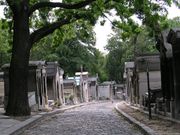 Père Lachaise, Chemin Errazu |
 Père Lachaise crematorium |
 Memorial to the dead |
 Jim Morrison's grave |
|
Marcel Proust's grave |
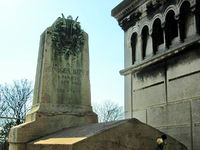 Georges Bizet's grave |
Frédéric Chopin's grave |
 Dominique Vivant, Baron de Denon's grave |
 Eugène Delacroix's tomb |
 Honoré de Balzac's bust and tomb |
Tomb of Marie Trintignant |
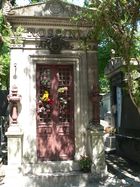 Tomb of Rossini |
|
Tomb of Cino Del Duca |
 Symbolical tomb of Maria Callas |
Tomb of Michel Petrucciani |
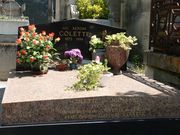 Tomb of Colette |
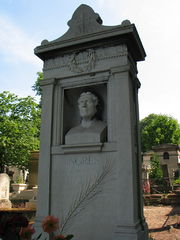 Tomb of Jean Auguste Dominique Ingres |
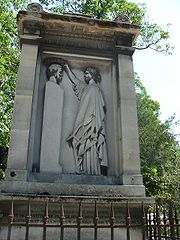 Tomb of Luigi Cherubini |
 Tomb of Georges Courteline |
Tomb of Pierre Bourdieu |
|
Tomb of Allan Kardec |
 Tomb of Sadeq Hedayat |
 Tomb of Gholam Hossein Saedi |
Tomb of Fernand Arbelot |
|
Tomb of Oscar Wilde by Jacob Epstein |
Tomb of Henri Salvador and his wife Jacqueline Salvador |
Tomb of Molière |
Tomb of Joseph Louis Gay-Lussac |
|
Buchenwald-Dora memorial |
Monowitz-Buna (also known as Auschwitz III) memorial |
Mauthausen memorial |
Ravensbruck memorial |
References
- ↑ New York Times travel article
- ↑ "Maurice Grimaud dies at 95; former Paris police chief". Associated Press (Los Angeles Times). 2009-07-24. http://www.latimes.com/news/obituaries/la-me-maurice-grimaud24-2009jul24,0,5216593.story. Retrieved 2009-07-29.
- ↑ New York Times: Jim Morrison's Fans Keep His Fire Alight. December 9, 1993.
External links
- Tour Père Lachaise Cemetery
- Père Lachaise Cemetery - virtual tour in French and English
- Cimetière du Père-Lachaise
- Photographs of Cimetière du Père-Lachaise
- [1] E-book "Voluptuous Death" Photography from Père-Lachaise Cemetery
- Information and news about Père-Lachaise In English
- Photographs of Père-Lachaise Documenting funerary statuary in Paris cemeteries; on pariscemeteries.com
|
|||||||